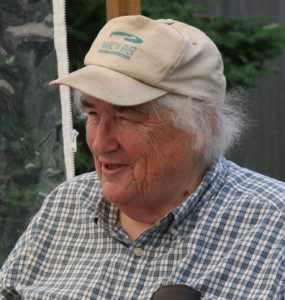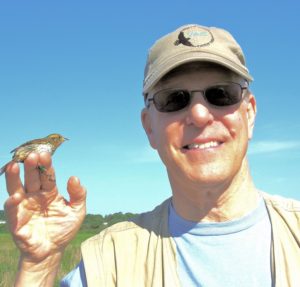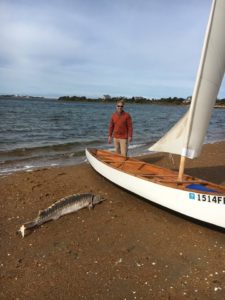Stone, Sturgeon, and Golden Eyes: Celebrating RI Natural History Week

A short nosed sturgeon on the beach at Block Island. Photo: The Ocean View Foundation.
It lay on the Block Island beach in October, looking for all the world like a medieval missile. Four feet long, body fortified with bony plates. A shortnose sturgeon, a fish that normally resides in rivers and a species that has been cruising around North American waters for 70 million years, had somehow washed up on the beach, at least twelve miles from the nearest river. How did it get there? Was this a completely random accident, or is there something going on in the environment that brought it there? Kim Gaffett, board member of the Rhode Island Natural History Survey (RINHS), found the displaced carcass and knew she had discovered something extraordinary.
In a way, that discovery captured the spirit of what RINHS was celebrating at its recent annual gathering: finding things in the natural world, asking questions, seeking answers, and sharing those discoveries with others. The event capped the 2016 RI Natural History week, and recognized naturalists who have devoted their lives to expanding knowledge of the outdoors, along with those making exceptional contributions in a shorter term.
Distinguished Naturalists Jon Boothroyd, Steven Reinert Recognized
Jon C. Boothroyd, former state geologist and geosciences research professor at URI, was given a posthumous award for his work as a naturalist, professor, and for his lifelong effort to research and educate both students and the public about geology. According to Dr. Bryan Oakley, Boothroyd’s former student and current assistant professor at Eastern Connecticut State University, “What set Jon apart from many other scientists was his desire and ability to make himself available to the public (in order to) pass that knowledge on to those outside of academia. He was remembered by Rhode Island Coastal Resources Management Council’s Grover Fugate as ‘constantly imparting his knowledge. He was always an educator, willing to talk to any audience. That was a hard skill to replicate.’”

Jon Boothroyd. Photo courtesy RINHS.
Oakley noted that Boothroyd was “one of the first scientists to understand the science and risk of rising sea levels, a concept that wound its way into every presentation he gave over the last 30 years.”
Steven E. Reinert, the other Distinguished Naturalist award winner, is in the unique position of being an accomplished naturalist without being a full time scientist. His friend and former professor Frank Golet described him as “the embodiment of a naturalist, with distinction. His expertise spans from estuarine and coastal bird ecology to land bird migration for more than 35 years.” Reinert has authored several scientific papers and book chapters on birds, and is a Master Bird-Bander, conducting important research on Salt Marsh Sparrow ecology.

Steve Reinert. Photo courtesy RINHS.
“His commitment to including children in the wonders of the natural world is expressed with humor and enthusiasm,” Golet said. “Children from all socioeconomic backgrounds have been handed a bird to gently release back into the wild, after developing a new – and often awestruck – appreciation.”
A “Golden Eye”
RINHS awarded its “Golden Eye” recognition – given to someone making a current significant contribution to the field of natural science – to Aaron Hunt. According to RINHS, Hunt “has made it his mission to identify as many animals on Block Island as he can. As of August 2016, he had identified 1,335 species and documented them with 5,594 images submitted to the web site BugGuide.net. We know more about the biodiversity of Block Island than most parts of Rhode Island and Aaron Hunt is one reason why. For those of us who purport or aspire to document the biodiversity of our own surroundings, we would do well to follow his example.” Not bad for a 17-year-old, currently in his freshman year at Vanderbilt college.
“Ask questions about it”
David Gregg, Executive Director of RINHS, described the significance of the shortnose sturgeon find as one that extended beyond seeing something out of the ordinary. “This is an unusual fish that has made us ask questions. You want to find stuff that you don’t know…and ask questions about it; try to fit it into some frame that you understand, and then share that information with people who are also curious, or who may be able to use that information. The giant swallowtail butterfly is a southern species that used to be a lifetime discovery in Rhode Island. Nowadays, we compete with each other to see who will be the first to see one every year. (We find) the in shore lizard fish, and fire ants.
“If we’re going to understand what these are doing here, in this time of global climate change, it’s a more critical time to have people in the field recording information than ever before. It’s very important that we keep doing what we’re doing: the importance of keeping first hand records of real things alive in their natural environment and not rely on assumptions. To connect people who know stuff with other people who know stuff, or need to know stuff, and reach a better understanding collectively. That’s why we’re here today.”

Photo courtesy of The Ocean View Foundation.






